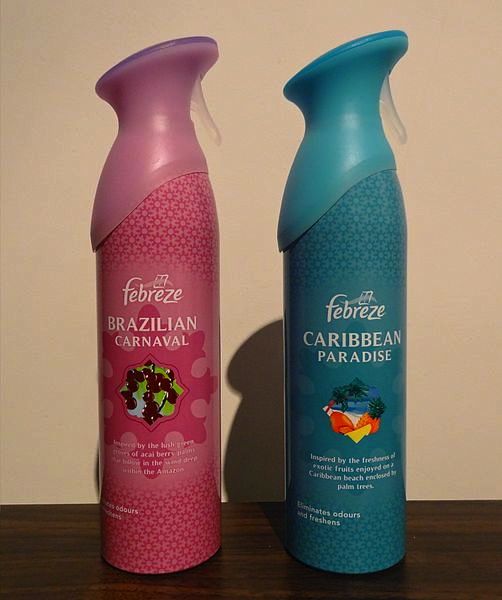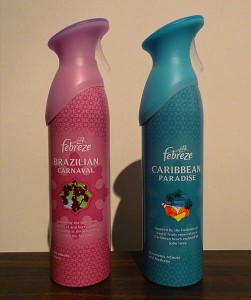
At CV Skinlabs, our mission is to deliver safety and efficacy, while helping restore and repair dry, sensitive, and stressed skin with our range of non-toxic skincare products.
We’ve talked about the dangers of air fresheners in previous posts. Today, I’d like to focus on Febreze Air Effects, a Proctor & Gamble product advertised as making odors, no matter how offensive, disappear.
A test by the Environmental Working Group (EWG) found that this product, like most synthetic air fresheners, releases a number of potentially harmful ingredients.
EWG Finds Carcinogen in Febreze
The EWG evaluated Febreze in 2009 to determine its safety as a school cleaning supply. Results showed that the product (Hawaiian Aloha option) released 89 air contaminants, including one carcinogen. Yet the manufacturer discloses only three of those ingredients.
This was a particularly high number-the third highest released by any product tested. According to the label, the air freshener contains only an odor eliminator, water, fragrance, non-flammable natural propellant, and quality control ingredients.
Could they get any more vague?
Here’s more on the chemicals the EWG found:
- Acetaldehyde: on California’s Prop 65 list for cancer and reproductive toxicity.
- Ethyl Acetate: a chemical toxic to the brain and nervous system.
- BHT: linked with neurotoxicity, hormone disruption, allergies, skin stress, and irritation to the skin, eyes, or lungs.
- Propylene glycol: linked with allergies and skin and eye irritation.
- 1,3-dichloro-2-propanol: also used in flame retardants, resins, plastics, and rubber; has been linked with cancer in animal studies, according to the California Environmental Protection Agency.
NRDC Found Similar Results in 2007
Interestingly enough, the National Resources Defense Council (NRDC) also tested 14 different air fresheners in 2007, including Febreze, and found they contained phthalates, which are hormone-disrupting chemicals and have been linked with childhood asthma. Again, none of the products disclosed these ingredients.
“Consumers have a right to know what is put into their air fresheners and other everyday products they bring into their homes,” said Dr. Gina Solomon, NRDC senior scientist. “There are too many products on the shelves that we assume are safe, but have never even been tested.”
Why You Should Use Natural Air Fresheners Instead
Is it time for you to change your methods of freshening your home? Here are seven reasons why we think you should switch to more natural methods like opening a window, burning a safe candle, using baking soda and vinegar to absorb and remove odors, or using an essential oil diffuser.
- Febreze and other chemical air fresheners do not remove the odor molecules-they simply cover them up. The odor molecules are still there, you just can’t detect them anymore. So after spraying the product, you’re not only inhaling the odor molecules, but the air freshener chemicals as well.
- Febreze contains chemicals linked to cancer.
- Febreze contains chemicals linked to hormone disruption and developmental problems.
- Febreze contains chemicals linked to neurotoxicity, which means the chemicals are poisonous to the nerves or nerve cells.
- Febreze contains chemicals that irritate the skin, eyes, and lungs.
- Febreze contains chemicals linked to allergies and asthma.
- Febreze doesn’t disclose any of these potentially harmful ingredients, so if it weren’t for studies like these by the EWG and the NRDC, we would have no idea what we were sniffing.
Have you stopped using Febreze and other chemical air fresheners? Please share your thoughts.
Picture courtesy Kroock74 via wikimedia.org.
Sources
“School Cleaner Test Results,” Environmental Working Group, November 3, 2009, http://www.ewg.org/research/greener-school-cleaning-supplies/school-cleaner-test-results.
“New Study: Common Air Fresheners Contain Chemicals That May Affect Human Reproductive Development,” NRDC, Press Release, September 19, 2007, http://www.nrdc.org/media/2007/070919.asp.
“Evidence on the Carcinogenicity of Tris(1,3-dichloro-2-propyl) Phosphate,” Reproductive and Cancer Hazard Assessment Branch, Office of Environmental Health Hazard Assessment, California Environmental Protection Agency, July 2011, http://oehha.ca.gov/prop65/hazard_ident/pdf_zip/TDCPP070811.pdf.


